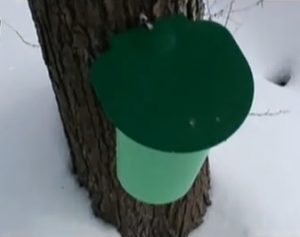When to Tap Maple Trees and Instructions on How to Tap Them
By Mark J. Donovan
|
|
In this video Mark Donovan of HomeAdditionPlus.com shows how to tap maple trees for producing 100% pure maple syrup.
One of nature’s sweetest treats is maple syrup. Nothing tastes as good on pancakes, French toast or crepes as 100% pure maple syrup. If you have maple trees in your yard, and live in a cold climate where you have below freezing temperatures at night and above freezing temperatures during the day for much of later winter and early spring you’re sitting on a golden opportunity. Or should I say a golden maple syrup opportunity.
With the above freezing temperatures during the day the sap flows and is ideal for collecting. The best sap, with the highest sugar content, occurs early in the sap collecting season. So don’t procrastinate with tapping your maple trees.
Tree Selection
Though sugar maples are the best trees to tap for producing maple syrup you can also tap Black Maples, Red Maples and Silver Maple trees. It is best to select and tag the trees in late summer or early fall, before the leaves change, so that you can properly identify them by their leaves.
Make sure to tap maple trees that are healthy and have a minimum diameter of 12 inches. As a general rule, you can install one tap on a tree between 12 and 20 inches in diameter. Trees between 20 and 26 inches in diameter you can install two taps. Trees greater than 26 inches in diameter, you can have up to three taps.
| Materials Required for Tapping Trees
You’ll need spiles (taps), the items that you actually tapped into the trees, spile hooks, buckets, and lids. You’ll also need a drill and either a 5/16 inch or 7/16 inch drill bit for drilling holes into the maple trees for the spiles. Note that you can use metal or plastic spiles. My preference are the metal spiles as they hold up longer and are not prone to breakage caused by hammering them into the tree. Make sure the spiles, buckets and lids are thoroughly cleaned, as if you were going to eat off of them. Make sure they are thoroughly rinsed after washing them with a dish detergent or bleach solution so that there is no residue of chemicals on them. |
 |
Make sure they are thoroughly rinsed after washing them with a dish detergent or bleach solution so that there is no residue of chemicals on them.
Tapping the Maple Tree
To actually tap the maple tree, drill a hole into the tree approximately 2 to 2.5 inches deep with either the 5/16 inch or 7/16 inch drill bit, depending on the diameter of the spile. The drill hole should be 2 to 4 feet off the ground and the drill bit should be slightly pitched upward when drilling into the tree. This will ensure that the sap flows downward and through the spile and into the bucket. Also, drill the hole on the south facing side of the tree and preferably over a large root or below a large branch of the tree. In addition, make sure you drill the hole at least 6 inches away from the previous year tap hole.
Make sure to clean the drilled hole of any sawdust debris. Then gently tap the spile into the tree using a hammer. If you are using metal spiles make sure to place the bucket hook onto the backside of the spile before tapping it into the tree. Make sure the hook is positioned such that a bucket can be hung off of it.
Lastly, place the bucket onto the tree and put the lid on top of it. With that you’re ready to begin collecting maple tree sap.
At the end of the season, after the sap has stopped flowing, remove the taps from the tree. Typically the sap stops flowing by late March or early April depending upon where you live. You don’t need to do anything else to the tree. The tap hole will heal on its own over time.
Dress Up Your Home’s Exterior with an Arbor – If you’ve always wondered what to do about a side door entrance to your house or garage to make it more appealing, or just wanted to simply spice up the backyard, building an arbor may be your answer. The “How to Build an Arbor Ebook” provides detailed, step-by-step instructions and pictures on how to build an entrance-way arbor for your home. Order and Immediately Download today!. 100% Money-Back Guarantee if you are not satisfied.
Planning to have a Brick or Paver Walkway Installed by a Landscaping Contractor but not sure what questions to ask to ensure you hire the right one? See HomeAdditionPlus.com’s Brick and Paver Walkway Bid Sheet. The Brick and Paver Walkway Bid Sheet will help ensure that your walkway project goes smoothly and you get the finished walkway you are looking for.
Additional Landscaping Resources from Amazon.com
 |
 |
Free Home Addition Price Quotes with No Obligation!
Fill out our 3-5 minute quick and easy form, and receive a free price quote on a house addition from one of our prescreened and licensed home addition contractors. This process is free and there is no obligation to continue once you receive your house addition price estimate.

